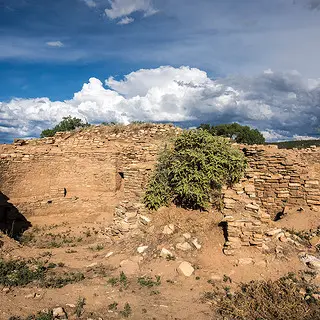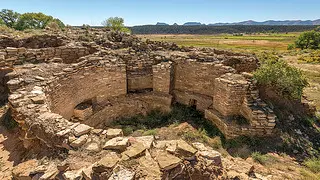
In Southwest Colorado, Archaeologists Find Key Clues to the Lives of Ancestral People
Archaeologists at the Haynie site near Cortez, Colorado, knew the property was important when they began a research project there in 2016. The land contains two Chaco-style great houses—monumental, intricately engineered sandstone structures built between A.D. 1100 and 1150. But after a few years of careful study, the field team identified an even earlier Pueblo I period village underneath the Chaco-style works. “A lot of these areas were occupied for hundreds of years prior to the Chaco-style architecture,” says April Brown, Southwest regional director at The Archaeological Conservancy (TAC), a nonprofit that owns most of the roughly 6-acre site.
A previous property owner had exposed parts of both great houses by conducting his own nonscientific excavations. He allowed archaeologist Susan Ryan from the nonprofit Crow Canyon Archaeological Center onto the land in 2008 to collect information about the age and layout of the Chaco-style structures, as well as other structures on the site. Crow Canyon eventually developed a research plan in collaboration with a group of Pueblo advisors and continued its work there. After TAC acquired the site in 2019, it permitted Crow Canyon to keep going with this project. “We acquire property with cultural resources, and then we preserve it for research,” says Cory Wilkins, TAC’s president and Western regional director.

photo by: Crow Canyon Archaeological Center
The two exposed Chaco-style great houses on the site, one of which is shown here, were constructed more than eight centuries ago.
Crow Canyon practices conservation archaeology, where one of the goals is to disturb ancestral Native American sites as little as possible. The ancestors of modern Pueblo people still inhabit the village, according to Pueblo culture, and the site may also hold ancestral connections for other communities. Because the two great houses had already been exposed, though, Crow Canyon archaeologists were able to learn more about them. The researchers gained information about what lay beneath them using minimally invasive techniques like electrical resistance surveys in the areas between and around these larger structures. “It took a little bit of geophysical work to understand the extent of the history of that site, and also limited testing to look below the ground surface and to notice that we had an entire huge Pueblo I period village [across the site],” says Ryan, who is now executive vice president of the Research Institute at Crow Canyon. She estimates that the village dates to “anywhere from 750 to about 950 A.D.”
Stay connected with us via email. Sign up today.
The multistory great houses’ decades of exposure to the elements have left them vulnerable to collapse. “Every time it rains or snows, [precipitation] will degrade mortar joints that hold those stones together,” Ryan says. TAC and Crow Canyon have stabilized them multiple times to preserve the architecture and keep the teams working there safe. A 2023 grant from the National Trust helped fund a recent stabilization, which entailed capping the tops of one great house’s sandstone walls to prevent water from running down its sides.
Ryan and her colleagues plan to finish their fieldwork at the site within the next two years. They have found pottery sherds; grinding tools used for food preparation, pigment production, and other tasks; and animal and plant remains, among other items. All provide valuable insights into daily life and environmental conditions. Earlier this summer Crow Canyon held a seven-week training program for college students from all over the country, who joined survey work at the Haynie site and a nearby site. Other programming includes specialized tours for children and adults.
“There’s relevance of this work to present-day societies across the world.”
Susan Ryan
The Crow Canyon team is in the process of analyzing its findings so far, and hopes to record information on everything from how the great houses were used to where inhabitants migrated from to how they responded to a changing natural environment. “There’s relevance of this work to present-day societies across the world,” says Ryan. “So what we’re trying to learn about the site will allow us to bring those insights forward into today.”
TAC and Crow Canyon have worked to remove invasive plants from the site. Brown says her team will re-seed with native grasses to prevent the invasive plants’ return, which is key to maintaining good relationships with surrounding farmers. To that same end, TAC has installed fences and gates to help keep cattle from wandering onto the property.
Before the great houses were exposed in the 1980s, they would have appeared as mounds in the landscape. “With the wind and dirt blowing, they just get buried over the centuries,” says Wilkins. Ultimately, TAC plans to backfill most of the site, meaning that it will methodically re-bury the structures in order to stabilize them and protect them from further decay. This process takes time to do correctly. “We have to fill all of the rooms in the great houses with dirt, a little at a time, and let it settle, or it could make things worse,” says Brown. “It’s very painstaking.” The exposed portion of the great house at the site’s northeastern corner, which TAC does not own, will remain uncovered.
TAC’s long-term goal is to place interpretive signage at the Haynie site and keep it open for limited tours. (Wilkins notes that, as part of TAC’s general management guidelines, Native Americans have access to all of its properties for ceremonial and other purposes.) “The site will essentially be used as an educational resource and a place where people can go and understand these villages,” Brown says.
Donate Today to Help Save the Places Where Our History Happened.
Donate to the National Trust for Historic Preservation today and you'll help preserve places that tell our stories, reflect our culture, and shape our shared American experience.



